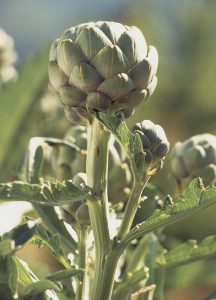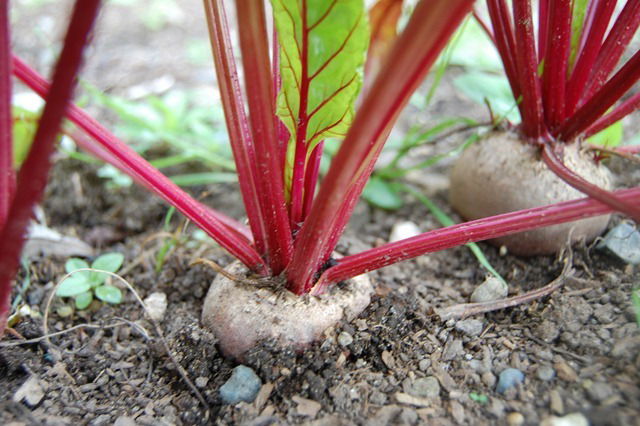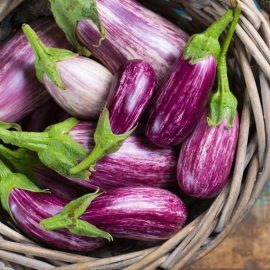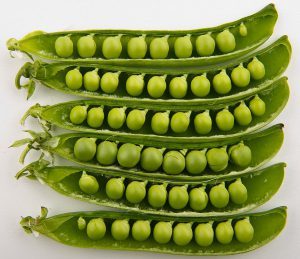Harvesting Tips, from Artichokes to Zucchini
If your experience with fresh produce so far has been only in the supermarket, where unchanging bins of your favorite vegetables lay in constant readiness, then your first gardening experience might be an eye-opener. Every vegetable has its peak window of opportunity for harvesting. Not knowing when to pick can leave you with broccoli that has gone to flower or zucchini that has grown giant overnight. Learning the optimum time to harvest is an important part of becoming a gardener.
Below are my own notes and opinions from a lifetime of growing my own. I also include suggestions for “thinnings,” meaning the extra seedlings that are pulled for proper spacing.
 Artichoke: No matter what size, harvest the buds while they are still tightly closed. The earlier you harvest, the more tender and edible the artichoke will be. (“Baby” artichokes are simply the smaller side shoots after the main flower bud is cut.) If you miss one and it has started to open, go ahead and let it flower; they’re beautiful.
Artichoke: No matter what size, harvest the buds while they are still tightly closed. The earlier you harvest, the more tender and edible the artichoke will be. (“Baby” artichokes are simply the smaller side shoots after the main flower bud is cut.) If you miss one and it has started to open, go ahead and let it flower; they’re beautiful.
Arugula: For salad, I think this green is best when very young—four weeks old and four inches high. Sow it often, between other seed rows to save space. No need for thinning. Pull out clumps and snip off the roots. Older leaves are better in cooked dishes.
Asparagus: In spring, cut stalks below ground level as soon and they are tall enough to use. The tips should be tightly closed. If not picked promptly, they will shoot up into a tall feathery fern, pretty but no longer edible. All asparagus stalks start out as thick as they are ever going to be, so don’t wait for a thin stalk to get thicker. In late spring when the plants are no longer producing thick shoots, stop picking and let the ferns grow to provide nourishment for next year’s crop.
Green Beans: Pick the pods young! Depending on the variety, they may be shorter or longer, but they should be pencil thin and crisp, with the beans inside still immature. Older bean pods with well-formed beans won’t be as sweet or as tender, but they can still be delicious, sliced and cooked a bit longer.
Lima Beans: Harvest pods while still bright green, but with the bulging beans showing their contours. Shelling them can be a challenge—use a paring knife to cut a thin strip off the outer curve of the pod, then pull the pod open to reveal the beans.
Fava Beans: It is easy to tell from the pods how large the beans inside are. You can harvest them the size of kidney beans and enjoy them raw or simply cooked. Larger beans, the size of lima beans, need to be boiled first and peeled individually for best results.
 Beets: the younger the beet, the sweeter and more tender. Beet roots that are 1-2 inches across are delicious. More often, beets are harvested when closer to 3 inches. Larger beets are not as tender but will be fine for roasting. Beet greens, if young and unblemished, can be cooked like spinach. Baby thinnings are prime salad material.
Beets: the younger the beet, the sweeter and more tender. Beet roots that are 1-2 inches across are delicious. More often, beets are harvested when closer to 3 inches. Larger beets are not as tender but will be fine for roasting. Beet greens, if young and unblemished, can be cooked like spinach. Baby thinnings are prime salad material.
Broccoli: Harvest the flower head while the buds are still small and closely packed. Take several inches of stem with it. If the broccoli head is small, it won’t get any wider. Once the buds begin to separate the vegetable loses its tender quality, and goes to flower very quickly. After the initial head is cut, smaller side shoots appear, providing a second crop.
Broccolini/Broccoli Raab: This plant is actually more closely related to mustard than broccoli, and it grows very fast. Cut flowering shoots before the buds open (though a few open flowers are not a problem) Include 6-8 inches of stems and leaves. Plants will put out a few more, smaller shoots after the initial harvest.
Brussels Sprouts: Sprouts mature along the stem from the ground up. Pinch them to see if they are firm and solid, then snap them off, or cut them cleanly with a knife.
 Cabbage: Cut when the head is solid to the touch. Don’t delay—if not harvested in time, the head will split and dry out. Sometimes, after the head is cut, smaller heads will form on the stem.
Cabbage: Cut when the head is solid to the touch. Don’t delay—if not harvested in time, the head will split and dry out. Sometimes, after the head is cut, smaller heads will form on the stem.
Carrots: Baby carrots, half an inch wide, are a true delicacy. Thin your planting to half-inch apart and harvest these tender beauties when the row gets crowed. Let the rest grow to one-inch diameter. Carrots can be harvested all season. The longer they stay in the ground, the larger they will be and the more cooking they will require.
Cauliflower: Harvest while the flower head is still tightly closed, before the stems begin to separate. Remove the plant as well; unlike broccoli there is no second crop.
Celery: Your garden celery will not resemble the supermarket bunches unless you blanch it by wrapping and tying the growing plants into bundles. It is far easier to let the plant grow freely and pull off outer stalks as needed. The flavor is stronger than blanched celery. Leaf tops are plentiful and can be used to flavor stocks and soups.
Cilantro/Coriander: This plant goes to seed very quickly. Sow it often and pick leaves as soon as they are usable. If you see a central flower stalk forming, pull the whole plant. Or you may wish to let it flower and enjoy the coriander seeds. They are particularly flavorful when still green.
Collard Greens: Harvest leaves while still bright green and unblemished. Snap the leaf stems off backwards so they break cleanly from the stalk. (Older leaves too tough to harvest should be left on the plant to nourish it.)
Cucumbers: Pick them small or just as they come to full size, before the seeds have a chance mature.
Sweet Corn: Corn is best picked right before cooking, as the sugars will begin to turn into starch. Some older books advise having the water boiling before you go out to the corn patch, though modern varieties stay sweeter longer. Peel back the husk and pierce a kernel with your fingernail. If it exudes a milky liquid, it is perfectly ready. If the liquid in the kernel is watery, it is not ready yet. If the kernel is dry, you have waited too long.
 Eggplant: Baby eggplant are a delicacy. If you let them get full size, pick while still shiny and firm, before the fruit has ripened and the seeds have hardened. Eggplants that are ripe will turn yellow and not be good to eat.
Eggplant: Baby eggplant are a delicacy. If you let them get full size, pick while still shiny and firm, before the fruit has ripened and the seeds have hardened. Eggplants that are ripe will turn yellow and not be good to eat.
Endive and Escarole: See Lettuce.
Fennel: Bulb fennel should be harvested while the base is still tightly closed, before it starts to elongate and flower. Wild fennel will not form an edible bulb, but the leaves can be snipped any time for flavoring. Fennel flowers are a delicious garnish for salad or pasta, and the seeds are delicious, either green or dried.
Kale: see Collard Greens.
Kohlrabi: Younger is best. Pick when the bulb is a few inches across.
 Lettuce: Can be harvested in many ways. Young thinnings make excellent salad greens—just snip off the roots. Mature plants can be pulled out completely, and this is best for Romaine or iceberg lettuce. For leaf lettuce, you may opt to extend the harvest by breaking off the outer leaves, leaving the plant to keep putting out more. Conversely, you may snip out the center of the head and let it regrow. This can be repeated two or three times. In any case, harvest the entire plant before it bolts, (sends up a central stalk.)
Lettuce: Can be harvested in many ways. Young thinnings make excellent salad greens—just snip off the roots. Mature plants can be pulled out completely, and this is best for Romaine or iceberg lettuce. For leaf lettuce, you may opt to extend the harvest by breaking off the outer leaves, leaving the plant to keep putting out more. Conversely, you may snip out the center of the head and let it regrow. This can be repeated two or three times. In any case, harvest the entire plant before it bolts, (sends up a central stalk.)
Leeks: The stalks should be thickened, though they might not be as large as those you find in the stores. A leek that sends up a flower stalk may be too tough to eat, but it may still be used for stock. Thinnings can be used like chives or green onions.
Melons: When fully ripe, cantaloupes will lose their green cast and the stem will show signs of separating from the fruit. Watermelons may make a thumping sound when you tap them—something I have never mastered–but the skin will become dull and the light spot where it sits on the ground will become yellowish when the fruit is ripe.
Mustard Greens: They grow very quickly. Thinnings and young leaves are nice in salads. Older leaves are for cooking. You may pull off leaves from time to time but the whole plant should be harvested before it bolts.
Okra: Smaller is better! Pick the pods when they are about 3 inches long for best texture and flavor.
Onions: Onions can be harvested at various stages. Seedlings can be thinned out for green onions. “Spring” onions are those that have started to form a bulb but remain green. As the bulbs enlarge, they can still be harvested and used in their green state. When the foliage begins to die down, the bulbs can be dug up for drying and storing,
Parsley: Break off outer leaves throughout the season. Parsley is a biennial. Plant it every spring and leave the plants in the ground over winter. The older plants will offer leaves before going to flower, while your new crop is getting started.
 Peas: Shelling peas should be picked as soon as the pods are filled out, and while still crisp and green. Older peas with limp pods will have a starchy texture. Sugar Snap peas are eaten pod and all and they can be picked sooner, when half full. Snow peas should be picked before the peas begin to form.
Peas: Shelling peas should be picked as soon as the pods are filled out, and while still crisp and green. Older peas with limp pods will have a starchy texture. Sugar Snap peas are eaten pod and all and they can be picked sooner, when half full. Snow peas should be picked before the peas begin to form.
Bell Peppers: Whatever the eventual color of the ripe pepper, red, yellow or orange, they can be picked while green or left to ripen. Pick while they are still crisp—left on the bush they will become dry and shriveled.
Chile Peppers: Various varieties are used either green, ripe or dried. For instance, jalapenos are usually enjoyed as a fresh green pepper, but ripened, dried and smoked, they become chipotles. Dried Ancho chiles, the base for mole sauce, are the same Poblano chiles used green for chiles rellenos.
Pumpkin: See Winter Squash
Radish: Like arugula, radishes grow in about four weeks and can be sown between other seed rows to save space. Thin to one inch apart and use the thinnings in salads. The younger and smaller the radish, the crisper and sweeter it will be. One inch or less is best. Larger radishes can be tough and bitter. Young radish tops are good for soups and stir-fries.
Rhubarb: Twist outer stalks so they break loose from the base cleanly.
Rutabaga: See Turnips
Spinach: Young seedlings are delicious as is. Full-sized plants should be picked promptly. The harvest can be extended somewhat by picking mature leaves like you might do with lettuce, but as spinach bolts more quickly, this should not drag on too long.
Winter Squash: All varieties of squash are grown in summer. “Winter” squashes, such as butternut, acorn, or pumpkin, are so called because they are stored for fall and winter use. Harvest when the outside is hard and the stem has shriveled, meaning that it has sealed itself off from the vine.
Summer Squash: See Zucchini
Squash Blossoms: Harvest the male flowers—the ones with thin stems. They should stay open on the plant for a day or two to pollenate the female flowers, and picked just when they begin to close.
Swiss Chard: Sow seeds thickly, because baby seedlings are great in salads and larger thinnings are delicious stir-fried. When mature, harvest leaves by giving the outer stalks a twist to snap them off at the base. Both stalks and leaves are edible.
 Tomatoes: Supermarket tomatoes are picked green for shipping and storage, and ripen off the vine. For vine-ripened flavor, harvest your home-grown crop after they have turned red (or yellow, or whatever their final color). For ease of handling you may pick them while still firm—they will soften at room temperature and still have their garden-fresh flavor. When the weather turns cold, pick the green tomatoes to ripen indoors—they won’t ripen well in cold weather.
Tomatoes: Supermarket tomatoes are picked green for shipping and storage, and ripen off the vine. For vine-ripened flavor, harvest your home-grown crop after they have turned red (or yellow, or whatever their final color). For ease of handling you may pick them while still firm—they will soften at room temperature and still have their garden-fresh flavor. When the weather turns cold, pick the green tomatoes to ripen indoors—they won’t ripen well in cold weather.
Turnips: Harvest while roots are still young and tender, 3 inches or so. Larger turnips might be stronger in flavor but still good to eat. Young turnip greens are prized by southern cooks, and some varieties are grown only as greens. Thinnings can be added to salads or to a pot of greens.
Zucchini: -ini means small in Italian. So pick your zucchini young, before they become oversized zucche! Zucchini grows so quickly in peak season you may have to visit the garden daily. Smaller squash, 5 to 8 inches long, have a delicate texture and full flavor. 10 to 12-inch zucchini will do for dishes calling for grated squash. In my opinion, squashes larger than that are bland and watery and better suited for compost. Some folks find them good for stuffing and baking, but there is nothing a big zuccha can do that a smaller zucchini can’t do better. (Exception: if you let a few zucchini get very large and ripen, they will turn orange and can be saved to make El Greco-style jack-o-lanterns for Halloween.)
- Joe Corso